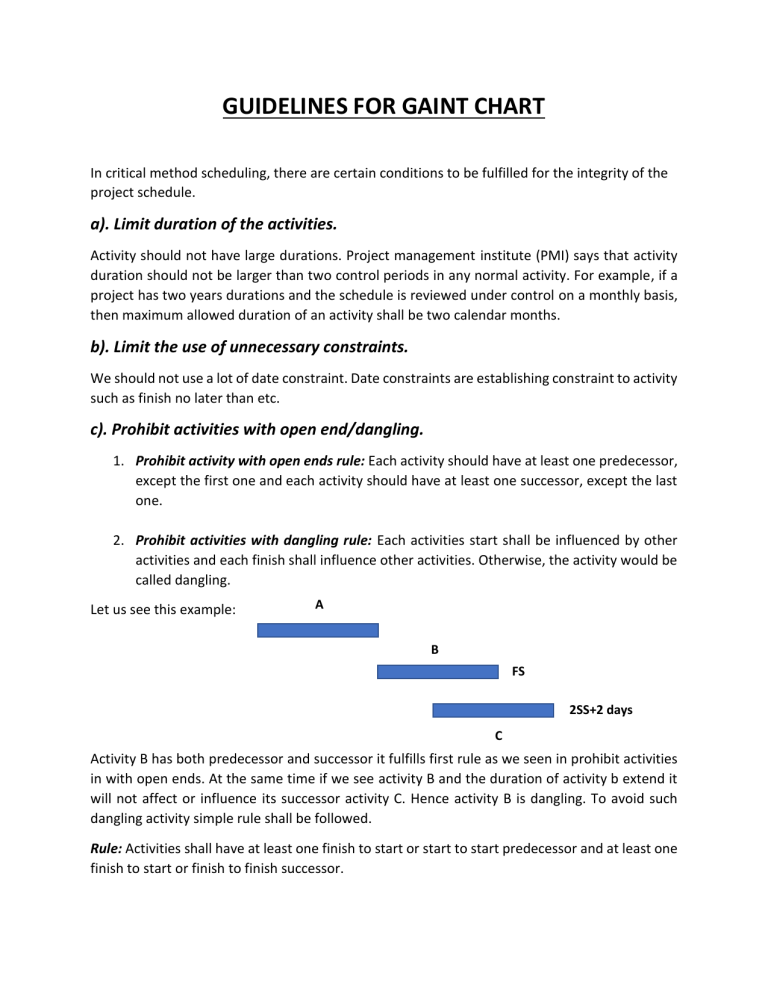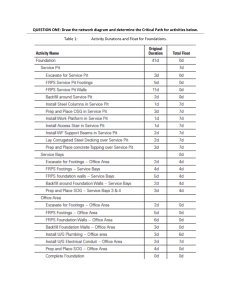
GUIDELINES FOR GAINT CHART In critical method scheduling, there are certain conditions to be fulfilled for the integrity of the project schedule. a). Limit duration of the activities. Activity should not have large durations. Project management institute (PMI) says that activity duration should not be larger than two control periods in any normal activity. For example, if a project has two years durations and the schedule is reviewed under control on a monthly basis, then maximum allowed duration of an activity shall be two calendar months. b). Limit the use of unnecessary constraints. We should not use a lot of date constraint. Date constraints are establishing constraint to activity such as finish no later than etc. c). Prohibit activities with open end/dangling. 1. Prohibit activity with open ends rule: Each activity should have at least one predecessor, except the first one and each activity should have at least one successor, except the last one. 2. Prohibit activities with dangling rule: Each activities start shall be influenced by other activities and each finish shall influence other activities. Otherwise, the activity would be called dangling. Let us see this example: A B FS C 2SS+2 days DDAYS Activity B has both predecessor and successor it fulfills first rule as we seen in prohibit activities in with open ends. At the same time if we see activity B and the duration of activity b extend it will not affect or influence its successor activity C. Hence activity B is dangling. To avoid such dangling activity simple rule shall be followed. Rule: Activities shall have at least one finish to start or start to start predecessor and at least one finish to start or finish to finish successor. d). Prescribe the use of certain logic relationships lag and lead: PMI says that we should use finish to start relationship for most of the activities. Start to finish relationship shall be used as little as possible. Do not use large lag in activity. PMI says that we should be careful with lags and do not use them instead of activities or completed relationship. Let’s have an example: We have an activity such as “Design xyz” and another activity like “Build xyz” and a relationship of FS+20 days. The 20 days are the need for the design approval. Design xyz Build xyz Here we have provided large lag. What is the alternative way to avoid this lag. Design xyz Design approval Build xyz The lag provided for design approval, build here an activity so, the lag is avoided. In this way large lag can be controlled. Similarly, we should not use large lead in the schedule. PMI says that we should be careful with large leads and use activities instead of them where possible. The reason is mainly leads are misused in the schedule (Whenever project is delayed planner has tendency to gradually increase the overlaps or leads to maintain the project completion date without any delay). It does not mean that we should not use any overlap, but it should be used in a very controlled manner. Let’s see the example: Build wall Paint wall Here there is an overlap period of 5 days. This is a lead shown in the above example. Let’s look at how to control this lead. To avoid overlap or lead, the following alternative may be used. Build wall part 1 Build wall part 2 Paint wall part 1 Paint wall part 2 e). Include all the tasks necessary to complete the scope of work: In addition to regular activities, adequate time for certain owner activities, including submittal review and procurement of owner furnished materials or equipment and shall include following task, if applicable. • • • • • Time for permitting or third party Concrete curing time. Inspection time and approval. Layout and its approval. Holiday. f). Avoid splitting the activities: It is not advisable to split activities because split activities are hard to manage, and we can implement an effective logic for them. Whenever we want to split an activity, we should break it down into two separate activities instead Split activity Split activity Splitting usually happens whenever we reschedule the plan. Float in the schedule Float is also called slack, there are two types of floats, free float, and total float. Free Float: Free float is the duration which an activity can be delayed in start or the finish date before delaying the successor activity. Total Float: Total float is the duration which an activity can be delayed in start or the finish date before delaying the project completion date. Note: Critical activity always has a free float and total float equal to zero. Near critical activity: Near critical activity are those whose float (slack) is equal to one shift or less. These activities have the potential to become critical. Project schedule compression techniques There are two types of project schedule compression techniques 1. Fast tracking and 2. Crashing Fast Tracking: Doing critical activities in parallel thereby reducing the project duration is called fast tracking scheduling. Crashing technique: By increasing the resources allocated to critical activities we can reduce the activity duration thereby reducing the project duration is called crashing the schedule.


